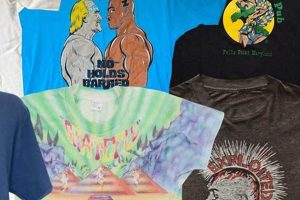A classic garment, typically made of cotton or a cotton blend, featuring designs and logos associated with the Green Bay Packers American football team and produced in a previous era. These shirts are often collected for their nostalgic appeal and connection to specific periods in the team’s history. For example, a garment displaying a particular Packers Super Bowl victory logo from the 1960s falls into this category.
Such apparel provides a tangible link to the past, embodying significant moments in the team’s legacy. Owning or wearing one connects individuals to a shared history and allows them to express their affinity for the Packers in a unique and often conversation-starting manner. These items can also hold considerable value, especially those from significant periods or featuring rare designs, making them sought after by collectors.
The following sections will delve into the factors that contribute to the value of these items, explore the characteristics that distinguish them from modern merchandise, and offer guidance on how to identify authentic examples.
Tips for Appraising a Vintage Packers T Shirt
Evaluating apparel from a previous era associated with the Green Bay Packers requires careful attention to detail. The subsequent guidelines offer insights into assessing authenticity and potential value.
Tip 1: Assess Fabric Composition and Construction: Examine the material. Older shirts frequently used single-stitch construction, indicating manufacture before the mass adoption of double-stitching in the late 1990s. The feel of the cotton can also indicate age; older cotton often has a different texture than modern blends.
Tip 2: Analyze the Graphic Design: Scrutinize the artwork’s printing technique. Screen printing was common, and the quality of the print can degrade over time, showing cracking or fading. Compare the design to known Packers logos and imagery from the purported era.
Tip 3: Inspect the Tag: Vintage tags contain information regarding the manufacturer, size, and sometimes the location of production. Research the tag’s brand and design to verify if it corresponds with the shirt’s claimed age. Pay attention to Union Made tags, indicative of production during a specific period.
Tip 4: Evaluate the Shirt’s Condition: The garment’s condition influences its value. While minor wear is acceptable, significant damage such as holes, stains, or excessive fading decreases desirability. However, a shirt in pristine condition is rare and potentially more valuable.
Tip 5: Research Historical Context: Knowledge of Packers history aids in identifying the significance of specific designs or logos. A shirt commemorating a particular championship victory or featuring a player from a notable era carries additional appeal.
Tip 6: Verify against available references: Consult online databases, collector communities, and price guides that specialize in sports memorabilia to cross-reference your findings. Comparison against validated examples can increase confidence in its value or authenticity.
Implementing these strategies will enhance the accuracy of assessing the worth of these historical pieces.
The concluding section will provide information on preserving and maintaining these valuable artifacts for future generations.
1. Era
The era in which a Green Bay Packers garment was produced is a fundamental determinant of its characteristics, value, and appeal. The period of manufacture influences design aesthetics, materials used, printing techniques, and ultimately, its historical significance.
- Design Aesthetics and Logo Evolution
Each era within the Green Bay Packers’ history is associated with specific logo designs, color schemes, and graphic styles. Shirts from the Vince Lombardi era (1960s) will feature different designs than those from the Brett Favre era (1990s-2000s). Identifying the correct logo or design style for a given period is crucial for authentication and understanding the garment’s historical context.
- Material Composition and Manufacturing Techniques
The types of materials used in shirt production have evolved over time. Earlier shirts were often made of 100% cotton, whereas later garments may incorporate synthetic blends. Similarly, manufacturing techniques such as single-stitch construction are indicative of older garments, typically pre-dating the late 1990s. Recognizing these material and construction differences provides insight into the shirt’s age.
- Cultural and Historical Significance
Garments produced during periods of significant team success, such as Super Bowl victories, or featuring popular players from a specific era often hold greater cultural and historical value. A shirt commemorating Super Bowl I (1967) carries significantly more weight than a generic team shirt from an uneventful season. The shirt embodies a tangible link to a specific moment in Packers history.
- Tagging and Branding Characteristics
The style and branding of the manufacturer’s tag can also serve as an indicator of the era in which the shirt was produced. Tag designs, brand names, and union labels have changed over time. Researching the history of specific tag designs can help narrow down the garment’s age and authenticate its vintage status.
In summary, considering the era of production is paramount when assessing the provenance and worth of a Green Bay Packers garment. Understanding the design elements, manufacturing techniques, cultural context, and tagging characteristics associated with different eras is essential for collectors and historians seeking to identify and appreciate these artifacts.
2. Material
The textile composition of a Green Bay Packers garment is inextricably linked to its classification as “vintage.” Material choices reflect the manufacturing practices and technological capabilities prevalent during its production era. Early examples predominantly utilized 100% cotton. This natural fiber offered breathability and comfort, aligning with textile manufacturing standards of the time. The specific type of cotton used, its weave density, and finishing treatments directly affect the garment’s durability, drape, and overall aesthetic. For example, a single-ply cotton shirt from the 1960s will exhibit a different texture and weight compared to a modern, ringspun cotton blend.
The transition from natural fibers to synthetic blends marks a significant shift in garment manufacturing. Polyester and rayon, introduced later, offered enhanced durability, wrinkle resistance, and color retention. The presence or absence of these synthetic fibers provides a valuable clue in determining the approximate age of a particular shirt. Furthermore, the printing methods employed on the material, whether screen printing, heat transfer, or direct-to-garment, correlate with specific eras and manufacturing processes. The integrity of the material, including its resistance to fading, shrinking, and tearing, directly influences its collectibility and market value. A shirt showcasing vibrant colors and minimal wear, despite its age, commands a higher premium.
In summary, the material composition serves as a key indicator of a Green Bay Packers item’s age, manufacturing origin, and potential value. By scrutinizing the fiber content, weave, and printing techniques, collectors and historians can more accurately assess its authenticity and historical significance. The material’s condition, reflecting its resistance to wear and tear, further impacts its desirability and overall worth within the market for vintage sports memorabilia.
3. Graphics
Graphics are integral to any garment, particularly those associated with a sports team. In the context of Green Bay Packers apparel, these designs represent visual embodiments of the team’s identity, history, and cultural significance. The specific imagery, typography, and color palettes utilized on a garment from a previous era serve as markers of its origin and authenticity. Variations in these graphical elements across different decades provide insights into evolving design trends and licensing agreements. For instance, a shirt from the 1960s featuring a minimalist Packers logo printed with a basic screen-printing technique contrasts sharply with a shirt from the 1990s showcasing elaborate graphics and multi-layered prints. These distinctions enable informed assessments regarding provenance and potential value.
The condition of the graphics significantly impacts the garment’s desirability and market value. Intact, vibrant graphics enhance appeal, while significant cracking, fading, or peeling diminish it. Collectors carefully examine printing techniques, such as screen printing, heat transfers, or flocking, to ascertain age and originality. For example, a shirt with a subtly cracked screen print might be deemed authentic, while one with a flawlessly pristine print may raise questions about its veracity. Furthermore, knowledge of specific designs associated with championship victories, notable players, or significant events increases its historical and monetary importance.
In summary, the graphic elements are not merely decorative additions but constitute essential components in determining the age, authenticity, and value of a Green Bay Packers apparel. Meticulous evaluation of design characteristics, printing methods, and overall condition enables a more nuanced understanding and appreciation of these vintage items. Identifying the correct graphics, recognizing printing techniques, and evaluating condition of graphics provides context for authentication, provenance, and value.
4. Tagging
The presence and characteristics of tags on a Green Bay Packers garment are critical determinants of its authenticity and age. Tags offer valuable information regarding the manufacturer, fabric composition, size, and origin of the item. Changes in tag design, branding, and content over time correlate directly with specific production periods. Consequently, discrepancies between a tag’s features and the garment’s purported era raise concerns about its legitimacy. For example, a shirt claiming to be from the 1960s bearing a tag with a brand logo that did not exist until the 1980s would be considered inauthentic.
Furthermore, union labels, commonly found on older garments, provide a reliable indicator of the production era. The presence of a specific union label, such as those associated with the International Ladies’ Garment Workers’ Union (ILGWU) or the Amalgamated Clothing Workers of America (ACWA), places the garment’s manufacture within a defined timeframe. The absence of a union label on a shirt claiming to be from a period when such labels were prevalent suggests potential alteration or misrepresentation. Examining the tag’s stitching, material, and printing quality can also reveal inconsistencies indicative of reproduction or counterfeiting. Authentic tags exhibit consistent and precise stitching, whereas reproduction tags may display irregular or poor-quality craftsmanship.
In conclusion, the meticulous examination of tags is essential for determining the authenticity and age of a Green Bay Packers garment. Tags provide valuable information regarding manufacturer, era, and origin, serving as critical identifiers for collectors and historians. Discrepancies in tag design, branding, or content can signal potential issues with authenticity, while the presence of union labels or careful inspection of stitching quality provides further verification. Thorough tag assessment enhances the ability to identify and appreciate genuine pieces of Packers history.
5. Condition
The physical state of a Green Bay Packers garment significantly influences its value and collectibility. The degree of wear and tear directly impacts its desirability among enthusiasts and historians.
- Graphic Integrity
The state of the printed design is paramount. Cracking, fading, or peeling of the graphics drastically reduces value. A garment with vibrant, largely intact graphics commands a premium, particularly if the design is rare or commemorates a significant team achievement. For example, a shirt from Super Bowl I with minimal graphic degradation is considerably more valuable than a similar shirt with extensive damage.
- Fabric Integrity
The fabric’s condition is crucial. Holes, stains, tears, and excessive fading diminish the garment’s worth. Minor wear, such as slight discoloration or a few small imperfections, may be acceptable, especially if the garment is exceptionally rare. However, significant fabric damage substantially decreases its value. The presence of original tags, even if detached, can offset some fabric imperfections.
- Structural Integrity
The seams, collar, and hem should be intact. Rips or unraveling in these areas detract from the garment’s overall appeal and value. Repairs, if professionally executed and minimally invasive, may mitigate some of the damage. However, extensive repairs often indicate significant wear and tear, negatively impacting collectibility. A shirt with intact seams and a well-preserved collar demonstrates better care and preservation.
- Overall Cleanliness
The presence of stains or odors significantly diminishes the garment’s appeal. While professional cleaning may improve its condition, aggressive cleaning methods can damage delicate fabrics or graphics. Subtle discoloration due to age may be acceptable, provided it does not detract significantly from the overall appearance. A clean, well-preserved shirt is generally more desirable and valuable than one with visible stains or lingering odors.
In conclusion, the physical state of a Green Bay Packers apparel directly influences its value and collectibility. A garment in excellent condition, with intact graphics, sound fabric, and clean appearance, commands a higher premium among collectors. Conversely, significant wear and tear diminish its worth, underscoring the importance of proper care and preservation.
6. Rarity
The scarcity of a Green Bay Packers garment significantly impacts its value and desirability within collecting circles. Items considered rare often command higher prices and greater attention from enthusiasts.
- Limited Production Runs
Garments produced in limited quantities, often for specific events or promotions, are inherently rarer than mass-produced items. Examples include shirts commemorating a Super Bowl victory or a player’s milestone achievement. The limited availability of these items increases their appeal to collectors.
- Unique Designs or Features
Shirts featuring atypical designs, color schemes, or printing techniques are considered rarer due to their deviation from standard team merchandise. These unique characteristics distinguish them from common items, making them more sought after. For instance, a shirt with a misprinted logo or an experimental design element would qualify.
- Player-Specific Merchandise
Garments associated with specific players, particularly those of historical significance or fan-favorite status, are often rarer due to lower production volumes compared to general team merchandise. A shirt featuring a player who had a short tenure with the team or was known for a particular game or season can be highly coveted.
- Era of Production
Shirts from certain eras, especially those predating widespread commercialization of sports merchandise, are naturally rarer due to the lower overall production volume during those periods. Examples include garments from the 1960s or earlier, when team merchandise was less prevalent. These items benefit from both their age and relative scarcity.
The interplay of limited production, unique features, player association, and historical context contributes to the scarcity of particular Green Bay Packers shirts. This scarcity, in turn, drives up their value and desirability within the collecting community, transforming them from mere articles of clothing into prized historical artifacts.
7. Authenticity
Verifying the genuineness of Green Bay Packers garments from previous eras is of paramount importance for collectors and enthusiasts. Establishing authenticity differentiates a genuine historical artifact from a reproduction or counterfeit item. Several factors contribute to determining whether a garment truly originates from its purported period.
- Tag Verification
The presence and characteristics of the manufacturer’s tag provide significant clues. Researching tag designs, logos, and associated trademarks helps confirm whether the tag aligns with the garment’s claimed era. Discrepancies, such as anachronistic branding elements, suggest inauthenticity. Authentic tags often exhibit specific wear patterns consistent with age.
- Fabric and Construction Analysis
Examining the fabric composition and construction techniques provides further verification. Older shirts often utilized specific cotton types and single-stitch construction methods. Inconsistencies in fabric composition or the presence of modern stitching techniques raise concerns about the garment’s authenticity. Microscopic analysis of fibers can sometimes reveal inconsistencies.
- Graphic Design Authentication
Comparing the graphic design to known team logos and imagery from the purported era is crucial. Subtle variations in color, font, or design details may indicate a reproduction. Official team archives and historical records serve as valuable resources for verifying the accuracy of graphic elements. The printing technique employed should also align with the technology available during the shirt’s supposed period of production.
- Provenance Documentation
Documented history, such as original purchase receipts, photographs, or letters of provenance, significantly enhances confidence in a garment’s authenticity. A clear chain of ownership strengthens the claim that the shirt is a genuine historical artifact. Items with well-documented provenance command higher value among collectors.
Successfully navigating these verification processes significantly enhances the ability to identify and appreciate genuine pieces of Green Bay Packers history. These practices ensure that investment are directed towards legitimate merchandise.
Frequently Asked Questions
The subsequent questions and answers address common inquiries regarding vintage Green Bay Packers shirts, providing clarity on their characteristics, valuation, and authentication.
Question 1: What characteristics define a Green Bay Packers garment as “vintage?”
Typically, the term “vintage” applies to apparel produced at least 20 years prior. Characteristics include design aesthetics reflecting past eras, specific fabric compositions common to those periods (e.g., 100% cotton), and manufacturing techniques like single-stitch construction.
Question 2: How does the condition of a Green Bay Packers garment influence its value?
Condition significantly impacts value. Shirts with minimal wear, intact graphics, and sound fabric command higher prices. Significant damage, such as holes, stains, or excessive fading, reduces value. Minor wear may be acceptable for exceptionally rare pieces.
Question 3: Where can authentic Green Bay Packers garments be located?
Potential sources include vintage clothing stores, online auction sites specializing in sports memorabilia, and private collectors. Thorough due diligence is essential to verify authenticity before acquisition.
Question 4: What factors contribute to the rarity of a Green Bay Packers garment?
Rarity arises from limited production runs (e.g., shirts commemorating specific events), unique designs or features, association with notable players, and the era of production (older shirts are typically rarer due to lower production volumes).
Question 5: How can the authenticity of a Green Bay Packers garment be verified?
Authentication involves examining the tag, analyzing the fabric and construction, authenticating the graphic design against historical team logos, and, if possible, verifying provenance through documentation.
Question 6: What role do tags play in determining the authenticity and age of a Green Bay Packers garment?
Tags provide crucial information regarding the manufacturer, fabric composition, and production period. Researching tag designs and branding helps confirm whether the tag aligns with the garment’s purported era. Union labels, commonly found on older garments, serve as further indicators of age.
Accurate valuation and authentication require a comprehensive understanding of these garments’ various aspects. Thorough research and careful inspection are crucial for collectors seeking to acquire authentic and valuable items.
The following section outlines guidelines for the proper care and preservation of these valuable artifacts.
Conclusion
The preceding analysis has illuminated the multifaceted nature of garments related to the Green Bay Packers from previous eras. Essential attributes, including material composition, graphic design, tag characteristics, condition, rarity, and authentication processes, contribute significantly to the determination of value and historical importance. Rigorous evaluation of these elements provides collectors and enthusiasts with the necessary tools to discern authentic pieces from reproductions.
Continued interest in and preservation of Green Bay Packers shirts serve to maintain tangible links to the team’s rich history. Diligent efforts in identifying, authenticating, and preserving these artifacts ensure that future generations can appreciate their cultural and historical significance. Responsible stewardship of these items promotes awareness of the team’s heritage and strengthens the connection between the past and present.







